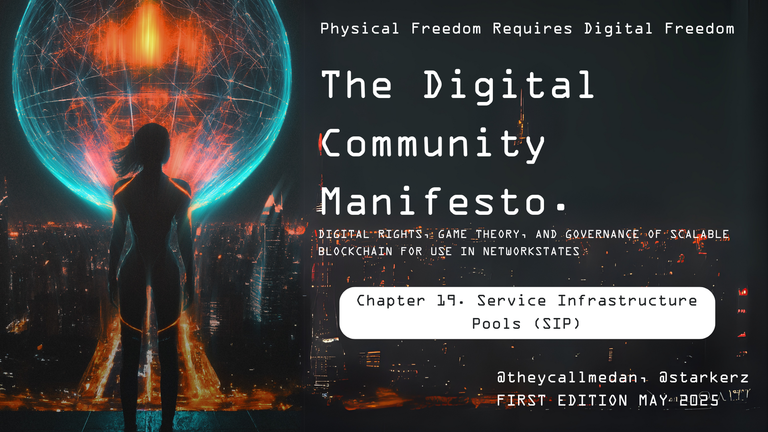Securing Digital Rights for Communities (Game Theory and Governance of Scalable Blockchains for Use in Digital Network States)
Chapter 19. Service Infrastructure Pools (SIP)
Paying the community instead of the exchanges

Introduction
A Service Infrastructure Pool (SIP) combines elements of a decentralised exchange (DEX) and a DAO. Normally, DEX trading fees go to a centralised operator’s profit. In a SIP, those fees are pooled and can be voted on by token holders to fund infrastructure improvements or other community initiatives.
19.1 Basic Concept – Send Exchange Fees Back to the Community
Instead of letting a centralised exchange collect trading fees, a SIP aggregates them into one pool. Stakeholders then decide how to use those pooled funds. They might pay infrastructure operators, fund new features, or distribute incentives that benefit the broader network. This is often coupled with a way for the SIP to sell an autonomous product or service. The revenue of which goes directly into providing additional liquidity to the SIP account. This allows the SIP to grow over time, potentially to a point where the fees generated from token exchanges are able to fund all or most of the infrastructure that is operating on the wider network.
19.2 Example from SPK Network
In SPK Network, users can buy mining tokens (like LARYNX) to improve their share of mining rewards directly from the SIP account. Purchasing these tokens requires locking up dollars (HBD or similar) in a liquidity pool. The key points are:
- Buyers of tokens place funds into a SIP account.
- Those funds stay in the pool and can be used for community-driven initiatives.
- The mining tokens give owners more “mining” weight or resource priority.
- If attackers want control, they must buy these tokens from existing holders, effectively paying the community their required rate for taking over the governance, after which the original community will likely fork, if the attacker is deemed as non benevolent to the protocol.
This setup discourages hostile takeovers because any large purchase of mining tokens raises the token’s price (benefiting existing holders), and the attacker’s funds permanently bolster the ecosystem’s liquidity.
19.3 Combining a DEX and a DAO
A typical DEX allows people to stake liquidity, earn fees, and withdraw profits. In a SIP, part of (or all) the funds remain in the pool rather than returning to individual stakers. The pool’s growing liquidity produces trading fees, and those fees can be:
- Sent to infrastructure operators.
- Allocated to development teams.
- Distributed for marketing, user incentives, or emergencies.
By design, it is like a DAO controlling a permanent liquidity stash, with revenue streams continuously replenished by users buying service tokens (e.g., mining tokens which improve a users mining capabilities in the network).
19.4 Required Technology and Combining Ecosystem liquidity
As SIP's grow they can be combined as multi-sig liquidity and collateral providers, stored on the base layer. For additional security, they can employ a massive mutli-sig technology such as BLS signatures. This allows for a reduction in size of the signature storage required in each block and therefore accommodates 400 up to thousands of keyholders on the main multi-sig account (SIP) in the eco-system. This means that much larger amounts of liquidity can be securely stored for various purposes by various parties on chain who seek increased security for their liquidity providers.
19.5 Self-Sustaining Ecosystem
Over time, more participants buying tokens for better mining efficiency drives more funds into the SIP. The liquidity pool gradually swells. As it does, it may earn enough in trading fees to:
- Pay for infrastructure without relying on external funding.
- Provide a safety net if outside market conditions weaken.
- Autonomously finance new ecosystem projects and expansions.
The end goal is an ownerless, decentralised “pot of liquidity” that pays for the chain’s operations and growth, acting like a shock absorber during market downturns.
19.6 Replacing centralised Exchanges
centralised exchanges such as Binance or Coinbase collect trading fees for corporate profit. A SIP, by contrast, directs its fees and other revenue streams into an on-chain pool governed by community votes. Rather than benefiting a few large shareholders, these funds can:
- Reward node operators.
- Subsidize new projects or Dapps. - Remain inside the community, strengthening the protocol overall.
This model reclaims revenue streams that would otherwise flow into centralised parties.
Key Takeaways
Autonomous Purchases
When users buy mining or service tokens from the SIP, funds go into the SIP and never leave, creating a permanent, increasing liquidity reserve.
DAO-like Control
The community decides how to allocate SIP reserves, ensuring democratic management.
Stability and Growth
As more people seek the service tokens, the SIP grows, generating fees that can fund infrastructure or offset downturns.
Reduced Attack Vectors
A would be attacker must inject significant capital to gain leverage, thereby strengthening the ecosystem
in the process.
Conclusion
Service Infrastructure Pools blend DeFi liquidity pooling with DAO governance to create sustainable, community owned revenue mechanisms. They transform trading fees into collective assets that keep infrastructure running and development funded, all without centralised exchange intermediaries.
Congratulations @networkstate! You have completed the following achievement on the Hive blockchain And have been rewarded with New badge(s)
Your next target is to reach 3000 upvotes.
You can view your badges on your board and compare yourself to others in the Ranking
If you no longer want to receive notifications, reply to this comment with the word
STOPCheck out our last posts:
Congratulations @networkstate! You received a personal badge!
You can view your badges on your board and compare yourself to others in the Ranking
Check out our last posts: